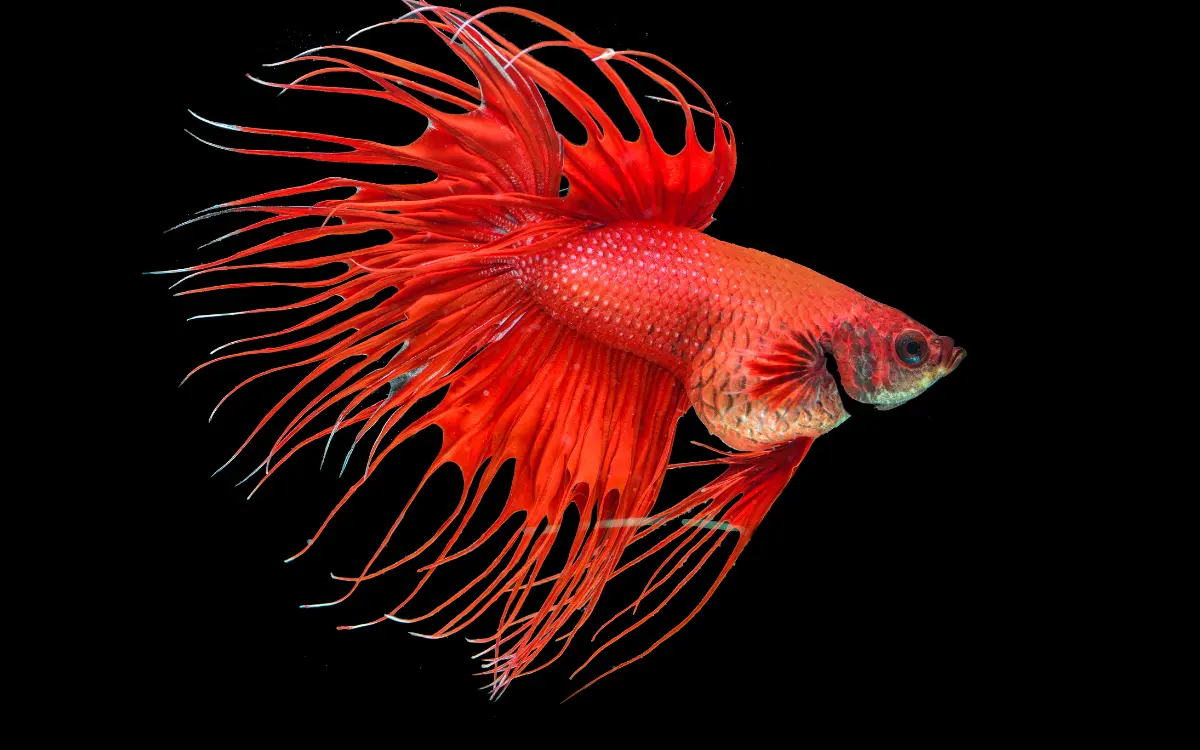Betta fish, or Siamese fighting fish, are stunning freshwater beauties from Southeast Asia. Known for their vibrant colors and flowing fins, they’re truly mesmerizing to watch.
However, these feisty fish need special care and their own space, as they don’t always play well with others.
A Betta can bring joy and wonder to any home, making them a captivating addition to your aquatic family.
Betta Fish Data Profile
| Attribute | Details |
| Family | Osphronemidae |
| Aggressiveness | High (especially males towards other males) |
| Minimum Tank Size | 5 gallons (10 gallons or more is ideal) |
| Life Span | 3-5 years with proper care |
| Diet | Carnivorous (pellets, flakes, live or frozen food like brine shrimp) |
| Size | 2.5 to 3 inches |
| Compatibility | Peaceful tank mates like snails, shrimp, and some small fish |
| Temperament | Territorial and aggressive (especially males); females can be kept together in sororities under careful management |
Types of Betta Fish To Explore
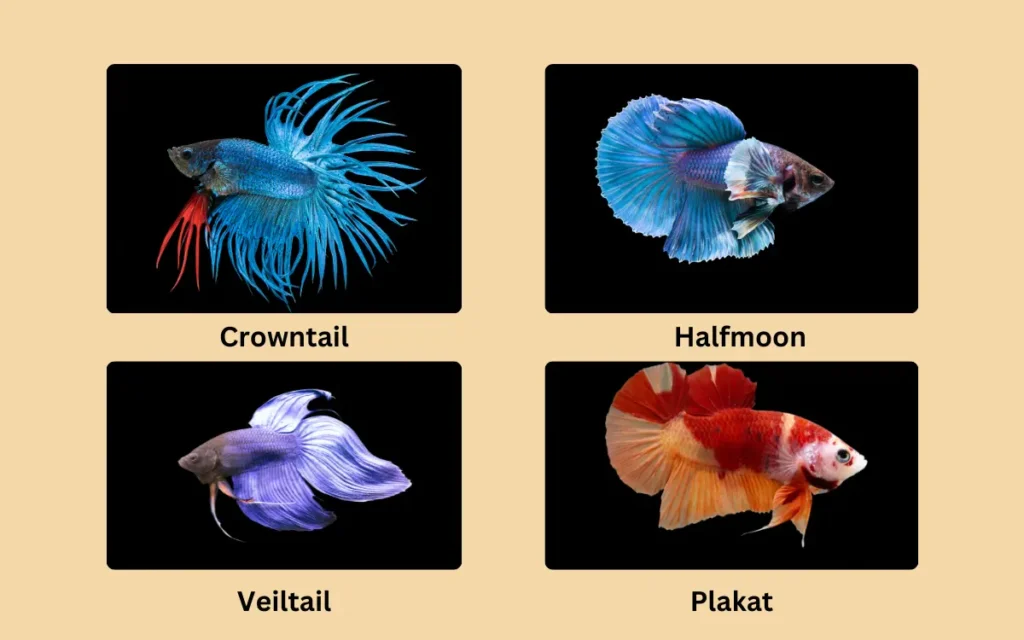
Betta fish come in many species and varieties, each with unique traits. Here’s a look at some common and rare types:
Common Types of Betta Fish
- Crowntail: Recognized for its spiky, crown-like fins.
- Halfmoon: Known for its stunning 180-degree tail spread.
- Veiltail: The most popular type, featuring long, flowing tails.
- Plakat: Short-finned, resembling wild Bettas with a rugged appearance.
Wild vs. Domesticated Betta Fish
- Wild Betta Fish: Found in nature, typically less vibrant but more resilient.
- Domesticated Betta Fish: Bred for bright colors and elaborate fins, requiring more attentive care.
Rare Betta Fish Varieties
- Alien Betta: Distinguished by unique patterns and metallic hues.
- Dragon Scale Betta: Features thick, metallic scales, resembling dragon armor.
- Koi Betta: Displays multi-colored patterns similar to Koi fish.
Color
Betta fish come in a stunning array of colors, making them highly sought after for aquariums. Some of the most popular colors include:
- Red: One of the most common Betta colors, symbolizing their bold and fiery nature.
- Blue: Vibrant shades range from deep navy to electric blue, often with an iridescent sheen.
- Green: Rare and usually mixed with other colors, giving a metallic or teal appearance.
- Yellow: Often referred to as “pineapple” Bettas, these have a sunny, bright hue.
- White/Pastel: These Bettas are either completely white or have a soft, muted coloration, creating an elegant look.
- Black: Rare and dramatic, with types like the Black Orchid Betta that have black bodies with contrasting colored fins.
- Purple: Highly prized for their unique and vivid hue, though pure purple Bettas are rare.
Pattern
Betta fish also display various patterns, each adding to their unique appearance:
- Solid: A single color covering the entire body and fins.
- Marble: A mix of two or more colors that change over time, giving a mottled effect.
- Butterfly: The body has one color, while the fins have a different color with a distinct band on the outer edge.
- Dragon: Thick, metallic scales that give the fish a powerful, armored look, usually with contrasting colors.
- Koi: Resembles the patterns of Koi fish, with blotches of various colors over the body and fins.
- Bicolor: Body and fins are two different colors, creating a striking contrast.
Betta Fish Behavior Explained
Male Betta Fish Behavior
Male Bettas are known for their high levels of aggression, especially toward other males. They are extremely territorial, often flaring their gills and fins to assert dominance and mark their space.
This behavior is also a way for males to attract mates. Because of this territorial nature, male Bettas are best kept alone or with non-threatening companions like snails or shrimp.
They frequently build bubble nests at the water’s surface as a sign of readiness to breed. Another common behavior is flaring at their own reflection, mistaking it for another male Betta, which can sometimes be a sign of stress.
Female Betta Fish Behavior
Female Bettas are generally less aggressive than males, though they can still display some territorial behavior, especially if the tank is small.
They can often live in groups, known as “sororities,” where a hierarchy forms but with less intense displays of dominance than males show.
Females may occasionally flare their fins, but they typically do so less frequently and with less intensity. While females do not build bubble nests, they may be curious about them during breeding.
They can coexist with other peaceful fish as long as there is enough space to reduce territorial disputes.
Related article:
What is the ideal Tank Size for betta ?
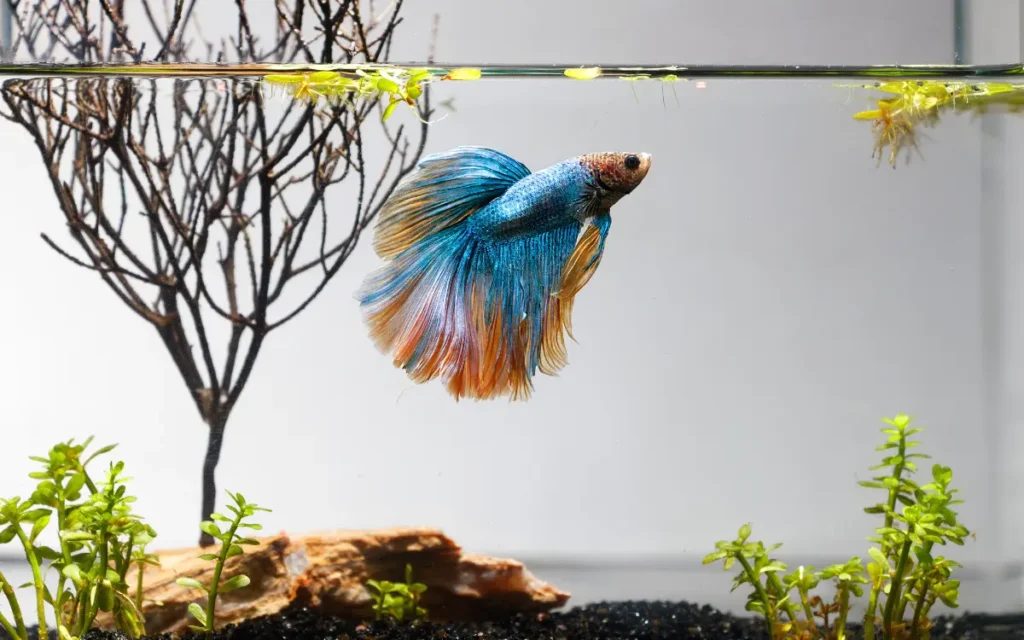
The ideal tank size for a Betta fish is at least 5 gallons, though 10 gallons or more is recommended for a healthier and happier fish.
Larger tanks provide better water quality, more stable temperatures, and enough space for your Betta to swim and explore, which helps reduce stress and promote natural behaviors.
Why 5+ Gallons?
- Water Quality: A larger tank allows for more water, which dilutes waste and makes it easier to maintain good water quality.
- Swimming Space: Bettas are active fish that enjoy exploring their environment, and a bigger tank provides them with plenty of room.
- Heating and Filtration: It’s easier to maintain consistent water temperature and filtration in a larger tank, both of which are important for Betta health.
While Betta fish can survive in smaller tanks or bowls, a tank of at least 5 gallons is strongly recommended to ensure they thrive.
Betta fish thrive best in stable, clean water that mimics their natural tropical environment. Here are the ideal water conditions for keeping Betta fish healthy:
1. Temperature
- Ideal Range: 76°F to 82°F (24°C to 28°C)
- Why?: Bettas are tropical fish and need warm water to maintain their metabolism and immune system. A heater is often necessary to maintain this range, especially in cooler climates.
2. pH Level
- Ideal Range: 6.5 to 7.5
- Why?: Bettas are adaptable but prefer slightly acidic to neutral water. Avoid sudden pH changes, as they can stress the fish.
3. Water Hardness
- Ideal Range: Soft to moderate (3-5 dGH)
- Why?: Bettas naturally live in soft water. While they can tolerate a wider range, it’s best to keep the hardness on the lower end to mimic their native habitat.
4. Ammonia, Nitrite, and Nitrate Levels
- Ammonia: 0 ppm
- Nitrite: 0 ppm
- Nitrate: <20 ppm
- Why?: Ammonia and nitrite are toxic to Bettas even in small amounts, so they should always be at zero. Nitrate should be kept low through regular water changes, ideally under 20 ppm.
5. Filtration
- Filter Type: A gentle filter is recommended, such as a sponge or adjustable filter.
- Why?: Bettas don’t handle strong currents well due to their delicate fins, so a gentle filter will maintain water quality without overwhelming them.
6. Water Changes
- Frequency: 25-30% every week
- Why?: Regular water changes help control toxins and keep the water parameters stable, which is crucial for Betta health.
Maintaining these water conditions will help ensure your Betta fish remains healthy, active, and vibrant!
Betta fish what do they eat?
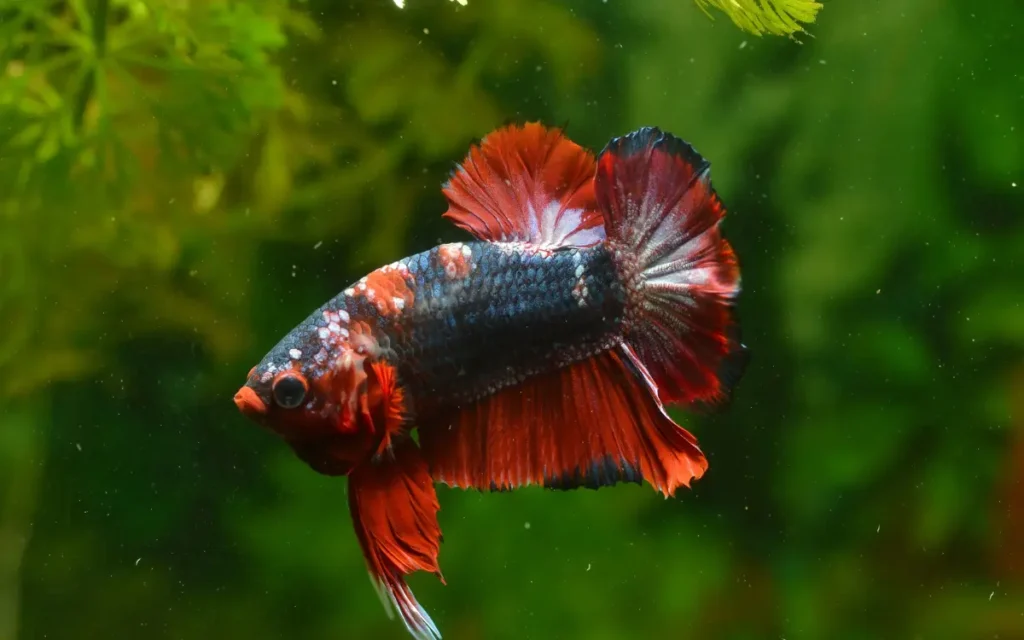
Betta fish are carnivorous and need a high-protein diet to stay healthy. Here’s a guide to what Betta fish eat and the best feeding practices:
1. Betta-Specific Pellets
Description: Betta pellets are specially formulated to provide the essential nutrients they need.
Feeding Tips: Choose high-quality pellets made with fish meal or other protein sources as the main ingredient. Avoid fillers like wheat and soy. Feed 2-3 pellets per meal, once or twice a day.
2. Live Foods
Types: Brine shrimp, daphnia, bloodworms, and mosquito larvae are all excellent choices.
Benefits: Live foods mimic a Betta’s natural diet, providing essential nutrients and encouraging natural hunting behavior.
Feeding Tips: Only feed live foods in small amounts to avoid overfeeding. Live foods can be given as an occasional treat or supplement.
3. Frozen Foods
Types: Frozen bloodworms, brine shrimp, and daphnia.
Benefits: Frozen foods offer the same benefits as live foods without the risk of introducing parasites.
Feeding Tips: Thaw a small portion of frozen food before feeding. Give frozen foods 1-2 times a week as a treat.
4. Freeze-Dried Foods
Types: Freeze-dried bloodworms, brine shrimp, and tubifex worms.
Benefits: Convenient and safe, as freeze-drying removes parasites. They are also a great source of protein.
Feeding Tips: Soak freeze-dried foods in water before feeding to prevent bloating. Limit to once or twice a week.
5. Occasional Vegetable Foods
Types: While Bettas are primarily carnivores, they can occasionally eat peas to help with digestion.Feeding Tips: If needed, feed a tiny piece of cooked, de-shelled pea to help with constipation. This should be given sparingly, maybe once a month.
Feeding Schedule and Tips
Portion Size: A Betta’s stomach is about the size of its eye, so overfeeding can lead to health issues. Feed small amounts once or twice a day.
Feeding Frequency: Bettas can be fed once daily or twice daily in smaller portions. Avoid overfeeding, as it can lead to bloating and swim bladder issues.
Fasting: Skip feeding one day a week to aid digestion and prevent constipation.
A well-balanced diet is essential for your Betta’s health, so try to provide a variety of food types to ensure they receive all necessary nutrients.
Types of Betta Fish Diseases
Betta fish can be susceptible to several diseases, often due to poor water quality, stress, or improper care. Here are some common diseases affecting Betta fish, along with their symptoms and treatments:
1. Fin Rot
Symptoms: Frayed, ragged, or discolored fins that appear to be rotting away.
Causes: Typically due to poor water quality or bacterial infections.
Treatment: Improve water conditions, perform regular water changes, and treat with antibiotics or aquarium salt to help combat bacterial infections.
2. Ich (White Spot Disease)
Symptoms: White spots on the body, fins, and gills, along with rubbing or scratching against objects.
Causes: A parasitic infection that thrives in poorly maintained tanks.
Treatment: Raise the tank temperature slightly (to around 82°F) and use an anti-parasitic medication. Performing daily water changes can also help eradicate the parasite.
3. Velvet
Symptoms: Gold or rust-colored dust on the body, clamped fins, and lethargy.
Causes: A parasitic infection that often arises due to stress or poor water conditions.
Treatment: Dim the tank lights, raise the water temperature, and treat with copper-based medications. Adding aquarium salt can also help.
4. Swim Bladder Disease
Symptoms: Difficulty swimming, floating sideways, sinking to the bottom, or struggling to stay upright.
Causes: Often due to overfeeding, constipation, or bacterial infections.
Treatment: Fast the Betta for 24-48 hours, then feed a cooked, de-shelled pea or try specially formulated Betta pellets to aid digestion. Maintain clean water and avoid overfeeding.
5. Dropsy
Symptoms: Swollen body, raised scales that give a pinecone appearance, and lethargy.
Causes: Often caused by a bacterial infection affecting the fish’s kidneys, resulting in fluid retention.
Treatment: Isolate the fish, improve water quality, and treat with antibacterial medication. Aquarium salt may help reduce swelling, but this condition is often fatal if advanced.
6. Columnaris (Cotton Wool Disease)
Symptoms: Cotton-like patches on the body, mouth, or fins, frayed fins, and ulcers.
Causes: Bacterial infection, often due to stress or poor water quality.
Treatment: Isolate the infected fish, maintain excellent water conditions, and treat with antibiotics. Salt baths can also be beneficial.
7. Popeye
Symptoms: One or both eyes bulging or swollen, often with cloudy appearance.
Causes: Bacterial infection, injury, or poor water quality.
Treatment: Improve water conditions and treat with antibiotics. Isolating the fish and adding aquarium salt can also help.
8. Fungal Infections
Symptoms: White, cotton-like growths on the body or fins, often near injured areas.
Causes: Poor water quality or secondary infection from an injury.
Treatment: Treat with anti-fungal medications, maintain clean water, and consider adding aquarium salt.
9. Parasites (e.g., Anchor Worm, Gill Flukes)
Symptoms: Visible worms on the skin, scratching, difficulty breathing, and clamped fins.
Causes: Parasitic infections from contaminated water or new fish that haven’t been quarantined.
Treatment: Use anti-parasitic medications, perform regular water changes, and ensure new fish are quarantined before adding them to the tank.
10. Bacterial Infections
Symptoms: Red streaks on fins, ulcers, lethargy, and loss of appetite.
Causes: Often due to stress or poor water quality, which makes Bettas more susceptible.
Treatment: Improve water quality, treat with antibacterial medications, and add aquarium salt to reduce stress and prevent further infections.
Is breeding betta fish easy ?
Breeding Betta fish is rewarding but challenging. Here’s a quick overview:
Breeding Tank Setup: Use a 5-10 gallon tank with a gentle filter, heater, and hiding spots. Keep the water at 78-82°F with a pH of 6.5-7.0.
Select and Condition the Pair: Choose healthy Bettas, 4-12 months old. Feed high-protein foods (live or frozen) for 1-2 weeks before breeding. Introduce them slowly so they can see each other without direct contact.
Breeding Behavior: The male builds a bubble nest, indicating readiness. When ready, the female displays vertical stripes. After a mating embrace, the male collects the fertilized eggs into the nest.
Care for Eggs and Fry: Remove the female after spawning. The male guards the nest until the fry are free-swimming, then he should be removed to prevent him from eating them.
Challenges: Breeding requires time, proper tank maintenance, and a separate space for growing fry. Ideal for hobbyists ready to invest in the process.
Breeding Bettas can be rewarding with the right setup, patience, and care.
Worst Betta Fish Tank Mates
| Fish Species | Reasons They Are Not Compatible |
| Goldfish | Different water temperature needs, produce a lot of waste |
| Guppies | Males have long, colorful fins that can trigger Betta aggression |
| Tiger Barbs | Known for fin-nipping, can stress and injure Betta fish |
| Cichlids | Aggressive nature, territorial behavior |
| Tetras (certain species) | Some species, like Serpae tetras, are fin-nippers |
| Angelfish | Can be aggressive and territorial, may attack Betta |
| Danios | Highly active, can stress out Betta fish |
| Other Male Bettas | Extremely territorial, will fight to the death |
Do I need live plants for betta fish?
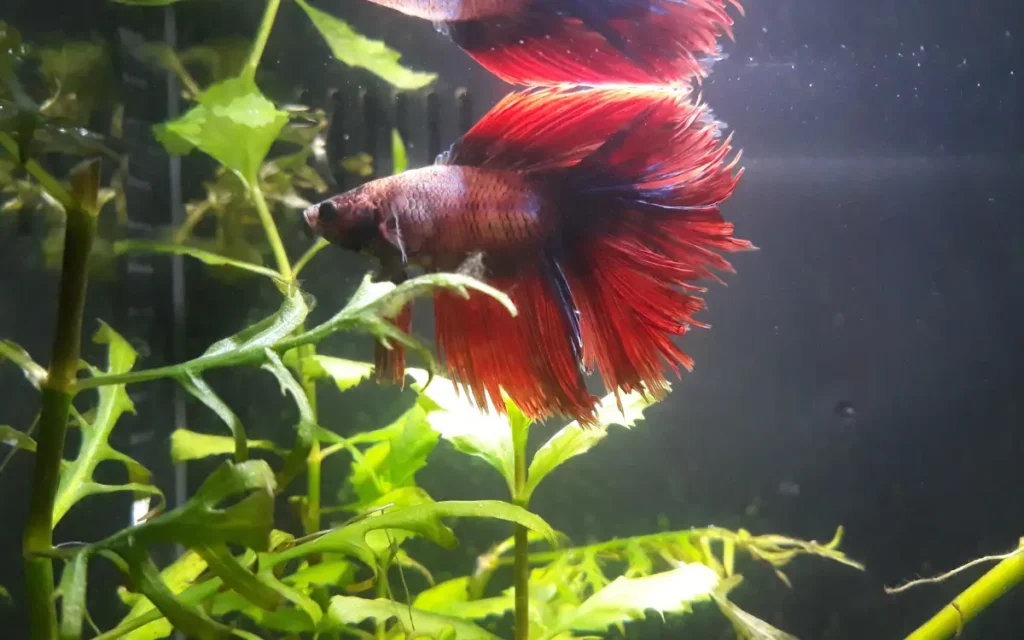
While live plants aren’t strictly necessary for Betta fish, they can greatly enhance your Betta’s environment and overall well-being. Here are the benefits of adding live plants to your Betta tank:
1. Natural Habitat Simulation
Bettas naturally thrive in environments with plants, as they provide hiding spots and make the tank feel more secure. Live plants mimic their natural habitat, reducing stress and helping them feel more at ease.
2. Water Quality Improvement
Live plants absorb harmful substances like ammonia, nitrates, and CO2, which improves water quality. They also produce oxygen, which benefits the overall health of the tank.
3. Stimulation and Enrichment
Bettas enjoy exploring and resting on plants. Plants like Anubias or Java Fern provide leaf surfaces where they can rest closer to the water’s surface.
4. Aesthetic Appeal
Live plants create a lush, natural look that enhances the beauty of the tank, adding color, texture, and a more authentic feel to the Betta’s environment.
Recommended Plants for Betta Tanks
- Anubias: Hardy, low-light plant that Bettas love to rest on.
- Java Fern: Easy to care for and grows well in low light.
- Marimo Moss Balls: Help absorb nitrates and provide gentle enrichment.
- Amazon Sword: Great for larger tanks and provides ample hiding spots.
Maintenance Considerations
Live plants require basic maintenance, such as occasional pruning and adequate lighting. Ensure the tank light is suitable for plant growth, and avoid strong currents, as Bettas prefer calm waters.
FAQs
How long do Betta fish live?
Betta fish typically live 3-5 years with proper care, but they can sometimes live longer in ideal conditions.
How long can a Betta fish go without food?
Bettas can survive up to 1-2 weeks without food, but it’s best not to go beyond a few days to prevent stress and health issues.
How big do Betta fish get?
Adult Betta fish usually grow to about 2.5 to 3 inches in length.
How often to feed Betta fish?
Feed your Betta once or twice daily in small portions, avoiding overfeeding to prevent health problems.
Why is my Betta fish not eating?
Possible reasons include stress, poor water quality, illness, or a change in environment. Check the tank conditions and observe for other symptoms.
Is Betta fish good for home?
Yes, Betta fish are great for homes! They’re easy to care for with the right setup and add beauty and tranquility to any space.
Is Betta fish a fighter fish?
Yes, Betta fish are also called Siamese fighting fish due to their territorial and aggressive nature, especially males.
Can Betta fish survive in cold water?
No, Bettas need warm water (76-82°F). Cold water can lead to stress, illness, and a shorter lifespan.
Why is my Betta fish blowing bubbles?
Male Bettas blow bubble nests as part of their natural behavior, especially when they’re ready to breed. It’s a sign they’re healthy and content!
Conclusion
Caring for Betta fish is simple and rewarding. Follow this guide for proper tank setup, feeding, and understanding their behavior. Choose compatible tank mates to ensure a peaceful environment. For more tips, explore our guide on freshwater fish. Happy fish keeping!

